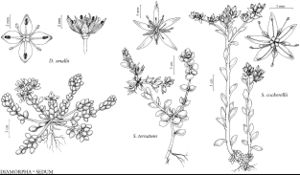Diamorpha
Gen. N. Amer. Pl. 1: 293. 1818, name conserved ,.
| Taxon | Illustrator ⠉ | |
|---|---|---|
 | Diamorpha Diamorpha smallii Sedum ternatum Sedum cockerellii | Yevonn Wilson-Ramsey Yevonn Wilson-Ramsey Yevonn Wilson-Ramsey Yevonn Wilson-Ramsey |
Herbs, annual, not viviparous, 0.2–1 dm, glabrous. Stems erect, simple or branching, fleshy. Leaves persistent, first crowded in winter rosette atop hypocotyl, remainder cauline, alternate, ± alike, not connate basally; petiole to 7 mm; blade oblong, subterete, 0.2–0.6 cm, succulent, base short-spurred, margins entire; veins not conspicuous. Inflorescences terminal, lax, corymbose cymes (with uniparous branches). Pedicels present. Flowers erect, 4-merous; sepals connate basally, all alike; petals spreading, distinct, white or pinkish; calyx and corolla not circumscissile in fruit; nectaries reniform; stamens 2 times as many as sepals; filaments free; pistils erect, connate 1/3–1/2 their lengths; ovary base rounded; styles 2+ times shorter than ovary. Fruits cruciate capsules, erect, with spreading, centrally connate pistils, dehiscent by abaxial valves. Seeds subglobose-ovoid, finely granulate-striate. x = 9.
Distribution
se United States
Discussion
Species 1: se United States.
Diamorpha is the only member of the family to have valved capsules instead of follicles that open along the ventral suture (rarely utricles), and it is notable also for its subglobose seeds. P. A. Sherwin and R. L. Wilbur (1971) worked out the floral anatomy of Diamorpha and of two species of Sedum sometimes thought related. They found Diamorpha remarkable for the solitary vascular strands of the sepals, the homocarpous adaxial carpellary traces, and the much-reduced abaxial carpellary bundle.
Species 1
Selected References
None.